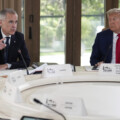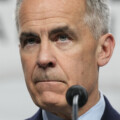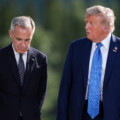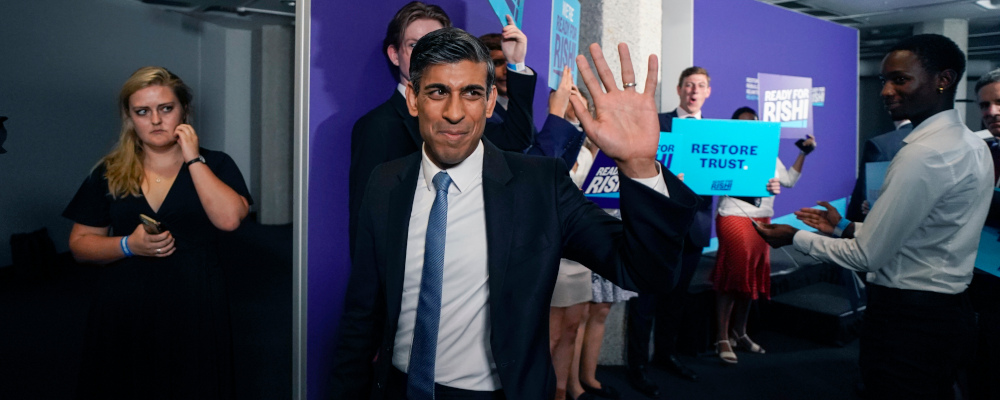The Conservative Party of Canada leadership race took a dramatic turn earlier this month when top-tier candidate Patrick Brown was disqualified over allegations that he broke party financing rules. Brown’s ejection from the contest has all but guaranteed that frontrunner Pierre Poilievre will become the party’s new leader on September 10th. It has also shone a light on the party’s continued struggles to attract and retain minority supporters since losing power nearly seven years ago.
Brown attracted a diverse crowd to the leadership contest as the incumbent mayor of Brampton, Ontario, Canada’s most heavily South Asian city. Prior to his untimely departure from the race, he recruited some 150,000 new members to the party, drawn disproportionately from immigrant and racialized communities. He also kept themes of inclusion and racial justice at the forefront of his now-defunct campaign; notably emerging as one of Canada’s loudest voices against Quebec’s anti-religious symbols Bill 21, which he has called “racist and discriminatory”. (As mayor of Brampton, Brown currently leads a group of 16 major Canadian cities that are funding a legal challenge to Bill 21).
Brown’s controversial exit from the Conservative Party leadership race is yet another setback for a party that has never fully recovered from a racially charged 2015 federal election campaign, replete with accusations of Islamophobic dog-whistling, and has more recently alienated Chinese-Canadian voters with its rhetoric on COVID and the People’s Republic of China. If the Conservative Party were looking to sabotage its chances in the next election, it’s hard to imagine a more effective way of doing so than by giving a middle finger to 150,000 new members who are largely non-white and geographically concentrated in Canada’s most “must-win” suburban swing ridings.
The Conservative Party’s rather monochromatic frontbench hardly inspires confidence that things will change for the better anytime soon. The party’s shadow cabinet is, in fact, shockingly pale for a government-in-waiting in a country where over 20 percent of the population is non-whiteCensus Profile, 2016 Census https://www12.statcan.gc.ca/census-recensement/2016/dp-pd/prof/details/page.cfm?Lang=E&Geo1=PR&Code1=01&Geo2=PR&Code2=01&Data=Count&SearchText=Canada&SearchType=Begins&SearchPR=01&B1=Visible%20minority&TABID=1 (a proportion that will only increase in the coming years). Dr. Leslyn Lewis, a Black woman and one of five remaining leadership contenders, was conspicuously snubbed of a critic portfolio after winning a seat in last fall’s federal election. This despite her impressive showing in the last leadership election (Lewis trailed eventual winner Erin O’Toole by a mere five percent in the second round of voting). Lewis’ omission from the shadow cabinet leaves just one person of colour, Shadow Minister of Foreign Affairs Michael Chong, in a prominent critic role. The dearth of Black and brown faces in the Conservative Party’s inner circle only reinforces the message that minority communities aren’t welcome or valued within the party.
But it doesn’t have to be this way. Just across the Atlantic, Britain’s Tories are in the throes of the most ethnically diverse leadership race ever run by a major Western party. Over half of the 11 candidates who declared their intention to succeed Boris Johnson as the party’s next leader (and next prime minister of the United Kingdom) earlier this month were ethnic minorities—a haul that included Rishi Sunak, the son of Indian immigrants, Iraqi Kurd Nadhim Zahawi, and the Nigerian-raised Kemi Badenoch. Sunak, formerly Britain’s Chancellor of the Exchequer, has since swept a series of caucus votes and is slated to go head-to-head with Foreign Secretary Liz Truss in a poll of rank-and-file party members in September. Once the smoke clears, there’s a good chance that Sunak will become just the second ever non-white leader of a Western country (following in Barack Obama’s footsteps).
How can two parties that descend from the same ideological family, and even share the same nickname, look so different?
Paradoxically, the changes within Britain’s Conservative Party can be pinned in part on the country’s stubborn cultural elitism. There’s a well-trodden path between the so-called “Oxbridge” network of elite British universities and prep schools and the Conservative Party’s frontbenches (Johnson and ex-prime minister David Cameron were famously part of the same all-male dining club in their Oxford days). As Britain’s most prestigious educational institutions have taken steps to diversify their respective student bodies over the years, one downstream effect has been a more diverse group of Conservatives in Westminster. Sunak, for example, is a graduate of Oxford’s Philosophy, Politics, and Economics (PPE) program, a degree long seen as an entrée into Britain’s political establishment.
While there is something of a pecking order among Canada’s colleges and universities (annual university rankings are just about the only thing keeping Maclean’s in print these days), our educational landscape is still nowhere near as hierarchical as Britain’s—which, to be clear, is probably a good thing. As such, tweaks to the respective admissions policies of McGill or U of T are unlikely to affect the composition of any party’s caucus (although cracking down on Greek Life at Western could greatly reduce the number of Canadian political scandals down the road).
Changes to party procedures for nominating candidates, implemented under former leader David Cameron, are another important part of the story. Shortly after becoming Conservative Party leader in 2005, Cameron introduced “A-lists” of prospective nominees, composed principally of women and minorities, for the consideration of electoral district associations (EDAs) in winnable ridings. The “A-list” system dramatically changed the composition of the Conservative caucus in a remarkably short period of time; by the time of Cameron’s departure in 2016, the number of Conservative MPs from ethnic minority backgrounds had increased six-fold.We were all white men — so I did something about diversity https://www.thetimes.co.uk/article/david-cameron-we-were-all-white-men-so-i-did-something-about-diversity-xlnnq7szm
Unfortunately, A-lists would be difficult, if not impossible, for the Conservative Party of Canada to replicate. Canada is a much (geographically) larger country than the United Kingdom and its party system is far more decentralized. “Open nominations” are a longstanding sacred cow of the Reform/Alliance wing of the Conservative Party and it’s difficult to fathom EDAs in Western Canada allowing Party HQ in Ottawa to shove binders filled with women and minorities down their throats. Any attempt to further centralize nominations, as Cameron was able to do in Britain, would only antagonize the EDAs and could potentially plunge the party into yet another internal crisis.
While structural reforms pursued by Britain’s Tories offer little guidance for Canada’s Conservatives, we can learn much from the party’s tone and messaging. One characteristic of the Tories that the Conservative Party of Canada can, and absolutely should, emulate is the party’s total embrace of civic nationalism: that is, an ethos of inclusive national pride built on shared admiration for a given country’s array of values an institutions.
Even as Britain’s Conservative Party has aggressively courted minorities, it has studiously avoided the sort of apologetic wokeness that now permeates the anti-racist left. Minorities within the party have been especially defiant of a left-of-centre metanarrative that casts them as helpless victims of structural racism. Minority Conservative MPs were, in fact, some of the party’s most fervent Brexiteers; today, they are among the loudest trumpeters of British exceptionalism. For instance, the aforementioned Kemi Badenoch was catapulted into political superstardom in the fall of 2020 when her speech to parliament excoriating critical race theory went viral.
While white progressives churn out think-pieces about how Western countries like Canada and the United Kingdom are white-supremacist hellholes, the bulk of minorities carry a quieter gratitude for the myriad opportunities such societies provide—most of us having roots in countries where citizens do not enjoy the same political and economic freedoms. My own parents, who were forced to flee their birth country of Uganda in the early 1970s (along with the rest of Uganda’s Asians), have never allowed me to forget how fortunate I was to grow up in such a free and prosperous country.
Canada’s ethnic minorities may not wear poppies in early November, but we generally like Canada and are grateful for the quality of life we enjoy here. In fact, surveys show that visible minorities generally express greater national pride than other Canadians.General Social Survey – Social Identity, 2020: A snapshot of pride in Canadian achievements among designated groups https://www150.statcan.gc.ca/n1/daily-quotidien/210928/dq210928c-eng.htm By daring to embrace an inclusive and full-throated civic nationalism, the Conservative Party of Canada can follow the Tories’ lead and become Canada’s party of diversity.
Recommended for You

Need to Know: Mark Carney’s digital services tax disaster

Theo Argitis: Carney is dismantling Trudeau’s tax legacy. How will he pay for his plan?

Kirk LaPointe: B.C.’s ferry fiasco is a perfectly Canadian controversy

‘I want to make Canada a freer country’: Conservative MP Andrew Lawton talks being a newbie in Parliament, patriotism, and Pierre Poilievre’s strategy




